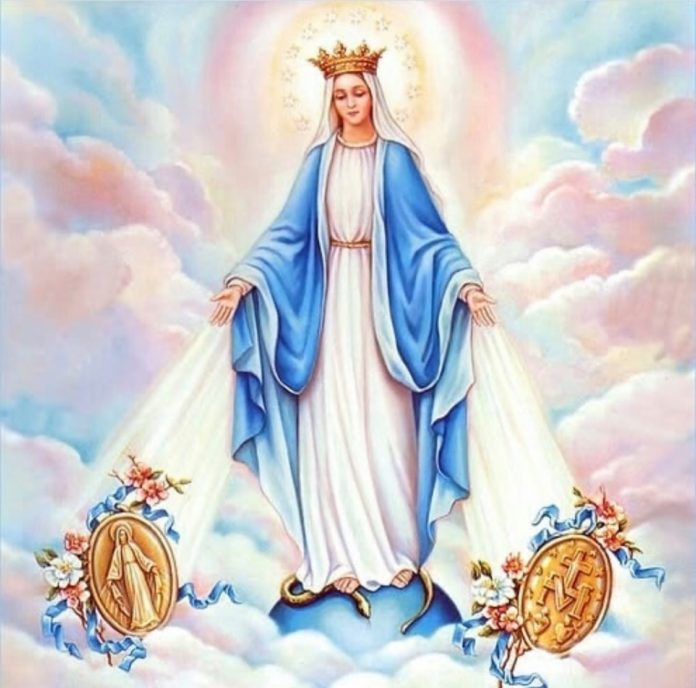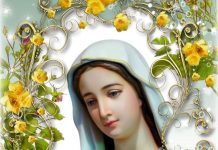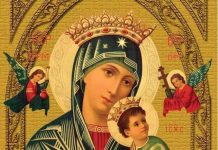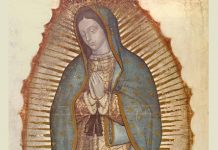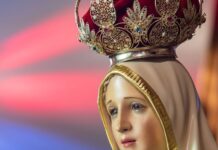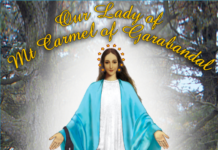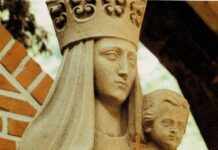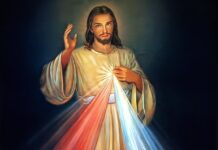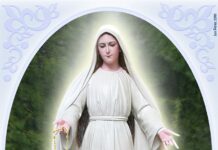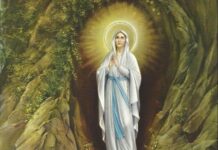St. Catherine Labouré and the Miraculous Medal The night of July 18, 1830 was a night that changed the history of the world. It was the night that the Blessed Virgin Mary ushered in the modern Marian era. It had been almost 300 years since the apparition of Our Lady of Guadalupe in 1531. This night in 1830 Our Lady’s apparition began a series of Marian apparitions, manifestations and ecclesial events that were to succeed one another down to our own day. We can very well see why Pope Paul VI declared, “Our era may well be called the Marian Era.” (The Great Sign, #6, p.11; May 13, 1967) That night in 1830 was a blessed night. The Holy Mother of God began her plans with a twenty four year old novice in the Motherhouse of the Sisters of Charity, on the Rue due Bac in Paris. That novice, whom we now know as St. Catherine Labouré, was sleeping in her curtained bed in the dormitory with the other novices. She was awakened by her Guardian Angel, who called her softly several times. She awoke to see her Angel as an extremely beautiful child about five years old, whose vesture was dazzlingly bright. The Angel said, “Come to chapel; the Blessed Virgin is waiting for you. “In following the Angel to the Chapel, Catherine was surprised to find that all the lights were lit as if it were for Midnight Mass on Christmas. She was led toward the sanctuary and knelt by the chair that the Director used when giving conferences to the Sisters. Suddenly she heard the rustle of silk and saw a most beautiful Lady walking toward her. The Lady was dressed in an ivory-colored dress with a blue mantle and a white veil covering her head and draping down over her shoulders. She sat down on the Director’s chair next to Catherine. The Angel told Catherine, “This is the Blessed Virgin.” Catherine leaned her hands on the Lady’s lap and looked into her Mother’s eyes. Preparing Catherine for the mission The Lady spoke, “My child, the good God wishes to entrust to you a mission.” She told Catherine that she would have to endure trials in carrying out the mission, but she would have consolation in knowing that she was working for the glory of God. The Lord would be with her and would guide her. “Have confidence. Do not be afraid,” The mission would be revealed at a later time. The Blessed Virgin told Catherine that she loved the Vincentian Communities and promised to protect them, but she complained, urging that there should be stricter observance of the Rules, more fervor in praying, especially the Rosary, and less worldliness in their lives. Sorrows for France The Lady continued, “The times are evil. Sorrows will come upon France; the throne will be overthrown. The Cross will be thrown down and trampled. The Archbishop will be stripped of his clothes. Blood will flow in the streets. The side of Our Lord will be pierced anew. The whole world will be afflicted with tribulations.” The Virgin appeared sad and could hardly speak as she said this. But as if giving a remedy, she pointed toward the foot of the altar and said, “Come to the foot of the altar. Here graces will be shed on all who ask for them. Graces will be shed especially on those who ask for them. “Our Lady specified other sorrows and tribulations that were to come: There will be victims in other Religious Communities and among the clergy. The Archbishop of Paris will be killed. The whole world will be in sadness. And she gave Catherine to understand that some of these things would take place soon, and others in forty years. Our Lady’s predictions came true. The following week, on July 27, 1830, a revolution broke out in Paris. The King, Charles X, was dethroned. The mobs desecrated churches, destroyed statues and threw down crucifixes and trampled them. Bishops and Priests were imprisoned, beaten and killed. Archbishop Hyacinth de Quelen of Paris had to flee into hiding twice to save his life. In another revolution, that of 1848, King Louis Philippe was dethroned and went into exile. Archbishop Affre of Paris was shot while trying to plead for peace at the barricades. Then forty years later, in September of 1870, yet another French Monarch was toppled, Emperor Louis Napoleon III, through the Franco-Prussian War. Six months later a revolution broke out in Paris. It lasted only two months; but before it was over, the sorrows and tribulations that had been predicted by Our Lady would be a matter of history. Many churches in Paris were desecrated, including the venerable church of Our Lady of Victories. Sacred things were publicly profaned. Even the graves and bodies of the dead were not spared. Many priests, both Diocesan and Religious were arrested; and finally thirty of them were executed, including Archbishop Darboy. True to the promise of the Blessed Virgin, the Vincentian Communities were saved, although the Sisters went through some very frightful moments. After having revealed these events to Catherine in 1830, the Blessed Virgin spoke to her about many other things which were for Catherine alone. Then Our Lady disappeared. The Angel, after having led Catherine back to the dormitory, also disappeared, just as the clock struck two in the morning. The groundwork for Catherine’s mission was now laid. God’s mission is revealed to Catherine The mission that God wanted to entrust to Catherine was made manifest to her on November 27, 1830. It was the mission of making and distributing the Medal of the Immaculate Conception, now known as the Miraculous Medal. That day was the Saturday before the first Sunday of Advent. The Sisters were gathered in the chapel as usual for prayers at five-thirty in the afternoon. Suddenly Our Lady appeared to Catherine. At first Mary appeared standing on a globe and dressed in white having with a long white veil which fell to her feet. The Virgin held in her hands, at the height of her shoulders, a golden ball which she seemed to be offering to God as she raised her eyes to heaven. Her fingers were covered with rings whose precious jewels sparkled brilliantly and showered down innumerable rays of light on the globe beneath her feet, almost obscuring the view of her feet. Mary lowered her eyes and looked directly at Catherine. Mary said nothing, but Catherine heard this message, “The ball which you see represents the world, especially France, and each person in particular. These rays symbolize the graces I shed upon those who ask for them. The jewels which give no rays symbolize the graces that are not given because they are not asked for.” Then the apparition changed. Our Lady appeared with a white dress, a blue mantle, and a white veil which draped back over her shoulders. She was still standing on the globe, and had one foot on the head of a serpent which lay at her feet. The 1830 was marked on the globe. The Virgin had her arms and hands pointed downwards, and a cascade of rays was falling down from both hands onto the globe. An oval frame formed around the Blessed Virgin, and written around within it, in letters of gold, was the beautiful prayer, “O Mary, conceived without sin, pray for us who have recourse to you.” This was the front side of the medal that was to be made. Then the vision revolved to show the reverse side of the medal. Catherine saw a Cross with a bar at its feet with which was intertwined an “M.” Beneath the “M” were the Hearts of Jesus and Mary, both surmounted by flames of love, one having a crown of thorns, and other pierced with a sword. Encircling all of this were twelve stars around the oval frame. The front side of the Medal: messages and symbolism On the front side of the medal we see the Blessed Virgin Mary as the Victorious Woman of Genesis. God Himself put enmities between the Woman and the serpent, a battle to be carried on “in that ‘monumental struggle against the powers of darkness’ which continues throughout human history.” (Mother of the Redeemer, #47, p.67; Pope John Paul II; March 25, 1987) On the medal we see Mary Immaculate with her foot crushing the head of the serpent. “She who as the one ‘Full of Grace’ was brought into the Mystery of Christ in order to be His Mother and thus the Holy Mother of God . . . remains in that mystery as ‘the Woman’ spoken of by the Book of Genesis (3:15) at the beginning . . . ” (Mother of the Redeemer, #24, p.23; Pope John Paul II; March 25, 1987). In many other official documents of the Church and writings of Saints we find Mary referred to as this Victorious Woman of Genesis destined to crush the proud head of the devil. “The Bible is replete with the mystery of the Savior, and from Genesis to the Book of Revelation, also contains clear references to her who was the Mother and Associate of the Savior.” (Marialis Cultus, #30, p.28; Pope Paul VI; Feb.2, 1974). The year 1830 was shown inscribed on the globe at the base of the Medal, so it is clearly meant to convey some message. It can very well indicate the year which begins the final stages of the battle between the Woman and the serpent, between good and evil. It could be Heaven’s way of indicated the year opening the Marian Era. Our Lady is standing on the globe of the world. Catherine could distinguish France in particular. In this we can see Mary both as the Victorious Woman and as the Queen of Heaven and Earth.Mary’s hands are shown showering a cascade of brilliant rays on the world, as if she found them too heavy with graces and was eager to pour them on us. We can see her as our “Advocate, Auxiliatrix, Adjutrix and Mediatrix. Of this intercession of hers for the People of God with the Son, the Church has been persuaded ever since the first centuries . . . ” (The Great Sign, Part I, p.4; Pope Paul VI; May 13, 1967). Around the oval frame of the medal we read the words, “O Mary, conceived without sin, pray for us who have recourse to you.” In this brief prayer we find the truth of (a) the Immaculate Conception of Mary, and (b) Mary’s intercessory power with God for us who ask for her aid. The reverse side of the Medal On the reverse side of the Medal we see a Cross, the symbol of Christ’s Redeeming Sacrifice on Mount Calvary for the salvation of the world. At the base of the Cross is a bar, which symbolizes the foot of the Cross. Intertwined with the bar is the letter “M” symbolizing the Mary’s intimate involvement at the foot of the Cross with her Son’s Redemptive Sacrifice. We see the “M” is below the line or foot of the Cross, signifying Mary’s subordinate role to that of Jesus. “This union of the Mother and her Son in the work of Redemption (cf. Lumen Gentium, #57) reaches its climax on Calvary, where Christ ‘offered Himself as the perfect Sacrifice to God’ (Hebrew 9:14), and where Mary stood by the Cross (cf. John 19:25), ‘suffering grievously with her only-begotten Son. There she united herself with a maternal Heart to His Sacrifice, and lovingly consented to the immolation of this Victim which she herself had brought forth’ (II Vatican Council, Dogmatic Constitution on the Church Lumen Gentium, #58), and also was offering to the Eternal Father.” (Marialis Cultus, #20, p.19, Pope Paul VI, Feb.2, 1974) It was also at the foot of the Cross that Jesus gave us, in the person of the Beloved Disciple, His own Mother to be our Mother. “Woman, behold your son; son, behold your Mother” (John 19, 25-27). And the beloved disciple gives us an example to follow, so that we learn to take Mary into our homes, into our lives, into our hearts, as do loving children. So the “M” stands not only for Mary, but also for Mother. “The new Motherhood of Mary, generated by faith, is the fruit of the ‘new’ love which came to definite maturity in her at the foot of the Cross, through her sharing in the Redemptive Love of her Son. Thus we find ourselves at the very center of the fulfilment of the promise contained in the Proto-gospel . . . (Gen. 3:15)” (Mother of the Redeemer, #23-24; p.33; Pope John Paul II; March 25, 1987). “Mary’s mediation is intimately linked with her Motherhood.” (ib. #39; p.54) Since the Cross is the symbol of Christ’s Redemptive Sacrifice, we can also see a Eucharistic symbolism on the Medal. “To perpetuate down the centuries the Sacrifice of the Cross, the Divine Savior instituted the Eucharistic Sacrifice [the Mass], the Memorial of His Death and Resurrection, and entrusted it to His Spouse the Church” (cf. II Vatican Council, Sacrosanctum Concilium, #47), which the Church continues to do “in union with the Saints in Heaven, and in particular with the Blessed Virgin.” (Marialis Cultus, #20, p.19-20; Pope Paul VI; Feb. 2, 1974). In every Eucharistic Liturgy the Church involves the Blessed Virgin Mary, so befitting to her who stood heroically at the foot of the Cross uniting her sufferings to the Sacrifice of her Son, filling up in her body those things that are wanting to the sufferings of Christ, for the sake of His Mystical Body, the Church. (cf. Col. 1:24). In all of the approved apparitions of Our Lady there is a Eucharistic thrust. She usually asked for a church to be built, in which the Eucharistic Sacrifice and the Blessed Sacrament always have prime place. Mary always leads us to Jesus, and Jesus is especially present in the Eucharist. On the Medal beneath the Cross and the “M” we see the two Hearts, the Sacred Heart of Jesus encircled with a crown of thorns, and the Immaculate Heart of Mary pierced with a sword. We see the prophesy of Holy Simeon fulfilled: the Son who was destined for the sign of contradiction, dying on the Cross, and the Mother pierced with a sword of sorrow beneath the Cross “so that the thoughts of many hearts may be revealed” (Luke 2, 34-35). The union of the two Hearts foreshadows the message of Fatima: “The Sacred Heart of Jesus wants the Immaculate Heart of Mary to be venerated at His side.” (Lucia Speaks, III Memoir, World Apostolate of Fatima, Washington, NJ: 1976; p.137). “God wishes to establish in the world devotion to my Immaculate Heart.” (ib. p.126) The two Hearts are surmounted by flames, symbolizing the burning love with which Jesus and Mary accomplished the work of Redemption, each in their proper way. No greater love does one have than to lay down one’s life. (cf. John 15:13). “Christ loved the Church and gave Himself up for her . . . ” (Ephesus 5:25-27) Around the oval frame of the Medal, encircling the Cross, the “M,” and the two Hearts, we see a crown of twelve stars. This can be seen as a reference to the “the Great Sign” in the Book of Revelation/Apocalypse; the “Woman clothed with the sun, with the moon beneath her feet, and on her head a crown of twelve stars.” The Woman engaged in battle with the “huge red Dragon . . . the ancient serpent, who is called the devil, or Satan” (Rev./Apoc. 12:3 & 9) is the Queen of the Apostles, the Mother of the Church. “The enmity, foretold at the beginning, is confirmed in the Apocalypse (the book of the final events of the Church and the world), in which there recurs the sign of the ‘Woman,’ this time ‘clothed with the sun’ (Rev. 12:1). Mary, Mother of the Incarnate Word, is placed at the very center of that enmity, that struggle which accompanies the history of humanity on earth and the history of Salvation itself.” (Mother of the Redeemer, #11; p.16; Pope Johne Paul II, March 25, 1987) We can see then in the Miraculous Medal a symbol of the whole history of salvation from Genesis to Apocalypse, and we can see the vital role that the Victorious Woman is destined in the final defeat of the devil. It is amazing how in such a small medal God can give us so many profound lessons. As is the case with all of God’s graces, it is up to us to humbly accept what He offers, as Mary did (cf. Luke 1:38), and to cherish and ponder it in our hearts, as Mary did. (cf. Luke 2:19 & 51) “Have a medal struck …“Catherine heard the voice telling her, “Have a medal struck after this model. All who wear it will receive great graces. They should wear it around the neck. Graces will abound for persons who wear it with confidence.” So this was the mission entrusted to Catherine: to see to the making of this medal and sto spread its use. During 1830 and 1831 this vision of November 27 was repeated some six times to encourage Catherine in fulfilling her mission. She had to suffer much for this cause; first in trying to get the medals made, and then in trying to keep herself hidden, which she did for forty-six years till she died in 1876. Catherine begins the struggle Catherine spoke to no one about her visions and her mission except her Spiritual Director, Fr. John Marie Aladel. He was only thirty years old in 1830, and this was no small task that was thrust upon him. He and Catherine had many confrontations before the first medals were struck in June 1832. Eventually, at his request, Catherine wrote out three full accounts of her visions. She was a person of sound common sense, had a great eye for details and a gift for describing well what she saw and heard. After almost two years of stormy discernment Fr. Aladel took advantage of a visit to Archbishop Hyacinth de Quelen of Paris in January of 1832 to discuss about his penitent, her visions, and the request of the Blessed Virgin for a medal to be struck. The Archbishop listened carefully and questioned Fr. Aladel in detail, and finally gave his permission for the medals to be made. He himself was very devoted to the Immaculate Conception of Mary and asked that he be given some of the first medals that would be made. The first two-thousand medlas were delivered on June 30, 1832. The spread of the Medal was almost like a miracle in itself. The first supply disppeared very fast. Pope Gregory XVI put one of them at the foot of the crucifix on his desk. The Redemptorist Founder of the Sisters Servants of the Immaculate Heart of Mary in America, Fr. Gillet, had the design of the medal placed on his ordination card in 1836. The stories of the cures and wonders of the medal helped to spread its use far and wide. By 1836 the firm of Vachette had sold several million medals. Eleven other engravers in Paris had done the same. And four engravers in Lyons were hard pressed to meet the demands for the medal. Canonical Inquiry Archbishop de Quelen instituted a Canonical Inquiry starting February 11, 1836. The conclusions of the Inquiry were that the Medal was of supernatural origin, and that the wonders worked through it were genuine. This Inquiry helped win approval of the Holy See in 1895 for a feast in honor of the Medal, and helped in the process of Beatification and Canonization of Sister Catherine. Wonders worked through the Medal Archbishop de Quelen attributed to the Miraculous Medal the deathbed conversion of a publicly impenitent sinner, Baron Dominique de Riom de Frolhiac de Fourt de Pradt. The Archbishop had tried to see him on several occasions and had been rebuffed. So he took a Miraculous Medal with him, and was finally allowed in to see the Baron, who was so touched by grace that he repented and confessed his sins. The next day he received the Sacraments from the Archbishop and died in his arms in 1837. Another of the stupendous workings of the Miraculous Medal was the conversion of Alphonse Ratisbonne on January 20, 1842. On January 15 he had been prevailed upon to wear a Miraculous Medal and say the “Memorare.” Alphonse was a staunch Jew, and had great antipathy for Catholicism. Yet on that day of January 20 he saw an apparition of the Blessed Virgin of the Miraculous Medal in all her dazzling glory, and his whole life was radically changed. Cardinal Patrizi, the Vicar of Rome, after a careful investigation, received Alphonse into the Church on January 31, 1842. Baptizing him, confirming him, and giving him First Communion. Alphonse became a priest and spent some thirty years in the Holy Land as a missionary to his own people. Death and Glory Sister Catherine died on December 31, 1876. In 1895 her cause for Beatification was introduced in Rome. She was beatified on May 28, 1933. When her body was exhumed, after fifty-seven years of burial,, it was found to be completely incorrupt and supple. Catherine was canonized a Saint on July 27, 1947. This approval by God and the Church was like a seal on the apparitions of Our Lady of the Miraculous Medal.— From Mary’s Touch #4 October 1997 |


